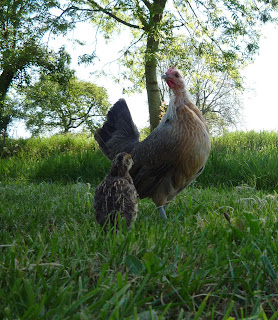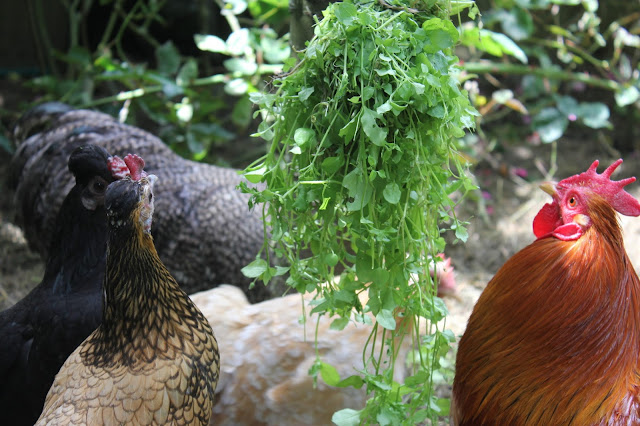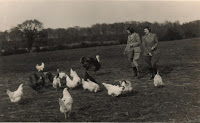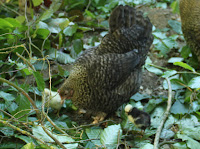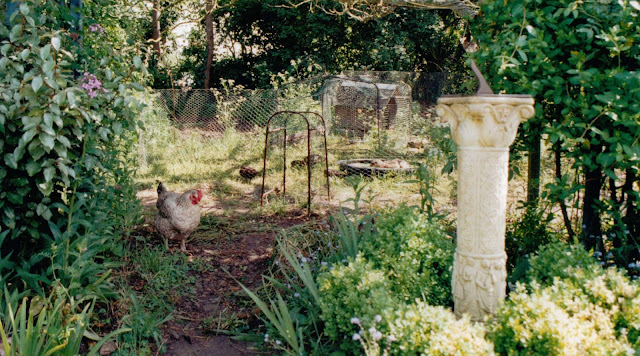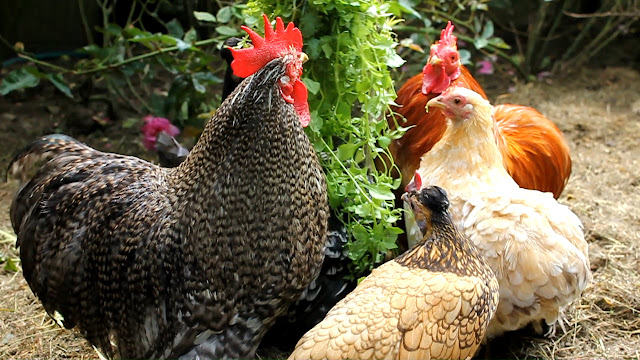I heard my first male quail call of the year today and to me it holds as much magic as that of the cuckoo. Our quail are a little late in their Spring song, possibly due to the terrible rain and dull days dampening any thoughts of romance and continuance. My females normally begin laying the day after the males start to call and as in the wild, these songs also encourage nest building. For the past week our quail, as a group, have started to remonstrate when I put them all in the same house at night, another sure sign of them beginning to pair off. Thus I have also started to increase the level of invertebrate protein.
Last year I began my organic mealworm farm, which I will be writing up shortly. This is to supplement the other invertebrates I collect from the various compost bins around our garden. I am also continuing to add greenery to their diet, other than that which is growing in their enclosure. Although protein obviously plays an important role in the egg laying and general optimum health of the quail, many of the processes involved are synergistic, requiring minerals and vitamins found within plant matter. To fulfil this requirement one of the easiest and most nutritious examples of forage to grow is water cress, nasturtium officianale. As you can see from the dirty beak evidence above, the watercress bed provides great opportunities. The quail can eat the leaves and 'garden' around the plants for some 'meat' to accompany the vegetable. Watercress is obviously also a great crop to grow for your other poultry too.
Food & Medicine
As the designator officinale suggests, watercress was one of the valuable medicinal plants used within the officina or medicinal still room attached to the physic gardens of mediaeval monasteries. It was here that the monastic herbalists, would dry and prepare medicinal and culinary plants. One of the most cited and earliest remaining architectural plans for a physic garden is that of Saint Gall, a Benedictine order famous for its knowledge of herbalism/phytotherapy. Pictured is the layout for St. Gall in 820 with its hospital and physic garden (top left), planted up with medicinal plants, including watercress.
Early European sailors also took watercress with them on board ship to prevent scurvy.
Hippocrates is said to have sited his first hospital on the Island of Kos near to a stream, to take advantage of a particularly abundant crop of watercress. So what is it that makes watercress so special? It's not just the quantity of individual vitamins and minerals but it is the quality of specifics, watercress is said to have high levels of Vitamin K, A, C, and relatively high levels of Calcium and Manganese
Watercress - vitamin and mineral rich from A to Z
Here is a list of watercress's most valuable nutrients:
The Vitamin A (Retinol) precursor: beta-carotene - this in quail is important not only as in humans for the health of eyes, skin, normal growth and development and the transport of calcium to the bones but also shell quality. Without sufficient vitamin A, calcium is deposited in the soft tissue thus risking heart conditions and skeletal problems. I have read on several occasions that the laying ability of quail is directly linked to the amount of vitamin A stored in the fat from the previous years intake of beta carotene. Beta-carotene also, has strong antioxidant properties and can protect quail from many potential conditions associated with free-radicals. Vitamin A deficiency also causes keratosis (see my article here), which encourages the proliferation of external parasites.
Vitamin B1 (Thiamine) plays an important role in converting carbohydrates and fats and proteins to energy. Thiamine protects quail against 'star-gazing' a common complaint, in my experience, in young quail hatched from commercial eggs and where the parents have been on a poor quality diet. Thiamine is crucial, along with other of the B complex vitamins, in the maintenance of a healthy nervous system.
Vitamin B2 (Riboflavin) as above, is responsible for the production of energy from food and the maintenance of a healthy nervous system, in particular Riboflavin works in synergy with B6 and B9. Riboflavin is also responsible for maintaining healthy blood cells. In quail and other poultry and game birds deficiency in Riboflavin causes curled toe paralysis which is fatal if left unattended - see my article on Riboflavin for a quick cure and prevention. Chicks hatching with low riboflavin can also have beak malformation.
Vitamin B3 (Niacin) as above with the other B vitamins, is responsible for the maintenance of optimal nervous system function. There is some recent research showing that there are possible side effects with supplementing with this vitamin in high doses, so getting a requirement through food rather than supplementation seems to me to be optimal. Chicks from deficient parents can have beak malformations
Vitamin B5 (Pantothenic acid) Again important for food conversion to usable energy and for optimal nervous system function. Vitamin B5 is crucial for the formation of acetylcholine, the primary chemical which allows the brain to communicate with the organs of the body. B5 deficiencies in quail can also result in poor feathering and low hatchability of eggs.
Vitamin B6 (Pyridoxine) As with all the B complex vitamins, Vitamin B6 plays an important role in a range of physical and psychological functions, including maintenance of an optimal immune system.
Vitamin B9 (Folate) Working in synergy with B12 (cobalamin) this is another important member of the B Complex family and with the same importance to nervous, physical and immune system function. Together the folate and cobalamin also have an important role in maintaining bone density. Deficiency in the parent can cause beak malformations in chicks.
Vitamin C (L-ascorbic acid) Although poultry are able to synthesise vitamin C it is also the first one to be flushed due to stress, with quail therefore, it is important to be aware of this, particularly during the breeding season and in hot weather. Vitamin C also plays an important role in egg laying and shell quality when the birds are under heat stress.
Calcium I like to give my birds oyster shell because I think this enables them to adequately judge for themselves how much they are taking in. I am also aware that wild birds use snail shells and other potentially calcium rich sources, such as calcareous grit to provide this mineral in their diets. However, plant sourced calcium was found in a study: Nutrition and Feeding of Organic Poultry (Blair 2008) to be as bioavailable to poultry as that of the usual sources of limestone and oyster shell.
Copper although a micro nutrient is important for digestive system function, feather production and hatchability of eggs. Low copper can result in heart conditions and as copper is a component of melanin, in reduced pigmentation in certain feather colours such as black, brown, grey, red and chamois.
Vitamin E is made up of eight compounds (Tocopherol/tocotrienols) it has antioxidant properties and is important for growth and nervous system recovery in times of stress. It has also been shown to have significant impact upon fertility in quail, in both sexes and upon the hatchability and general health of the chicks. Vitamin E is crucial in protecting eye and brain health and helps the body utilise vitamin K.
Gluconasturtiin, which provides the peppery flavor of many cruciferous vegetables and is particularly prevalent in watercress, is the precursor for phenethyl
isothiocyanates (PEITC), shown to inhibit carcinogens.
Iodine again a micro nutrient but essential for growth and development and in particular of the brain and nervous system because of its ability to synthesise thyroid hormones. Adult quail with insufficient iodine can pass on goitre (a swollen neck condition due to malfunctioning thyroid) to their chicks.
Iron is needed to produce haemoglobin, a protein found in red blood cells that carries oxygen from the lungs and transport it throughout the body. It also helps regulate cell growth, maintains brain function, metabolism, endocrine and immune system function and is involved in turning food into energy production. Without enough iron, a body will suffer chronic fatigue and as quail have a high basal metabolism this can be a real problem. Iron, as with copper and zinc also influences the richness of feather pigmentation.
Vitamin K1 (Phylloquinone) Vitamin K (in the main K2) has an important role in the transport of calcium to the bone and thus in quail and other poultry to the formation of shell. If calcium has formed in the soft tissue (arterial calcification) both phylloquinone and to a greater extent menaquinone (Vitamin K2), have the ability to reverse it. Vitamin K1 goes directly to the liver and is well known for its ability to help to clot the blood and avoid blood loss.
Lutein known colloquially as 'the eye vitamin' lutein protects eye health. Lutein is one of the few plant pigments or carotenoids which can accumulate in the macular pigment and macula lutea, the small central part of the retina of the eye, responsible for detailed vision. Furthermore it plays an important role in brain health and thus may prevent cognitive decline
Magnesium is responsible for cell division, muscle and nerve function including the heart, mitochondrial efficiency, bone density and the metabolism of various minerals including calcium, phosphorus, iron and zinc as well as several hundred enzymes and the activation of thiamine. As such it impacts on the laying process of the adult quail, eggshell thickness and the hatchability and subsequent growth of the chick.
Manganese is needed for optimal growth, shell quality and hatchability of eggs. Deficiency of manganese in quail and other poultry can cause perosis, a leg deformity, a condition where the tendons of the legs slip from the hock. Deficiency in the parent bird can lead to poor development of embryos and low hatchability, those chicks
that hatch are prone to poor feathering and slow development and or can suffer from malformation.
Phosphorus is important for a whole raft of physical and nervous system function. Plant-based phosphorus is often conjectured to be less bioavailable because it is bound with phytates. To me, this seems relevant only in the seed and grain form, which is understandable as the plant is protecting itself from its 'offspring' from being digested. My conjecture would be that within the leafy plant itself this would not be a problem. Phosphorus is also linked with bone density and the transport of calcium, thus in poultry with the formation of shell and hatchability of the chicks. Chicks deficient in phosphorus may also have soft beaks and bones (rickets).
Potassium is an electrolyte, thus balances the body's chemical and electrical impulses. It is important for various physical and nervous system functions, including the heart, brain, kidneys, muscle contractions, fluid levels and blood pressure. Deficiency causes low hatchability and retarded growth in chicks.
Quercetin is a type of flavonoid polyphenol a 'plant pigment' and a powerful antioxidant thus a free radical scavenger. It also has anti-inflammatory effects to protect the body against heart, circulatory and arthritic conditions as well as infection, allergies and fatigue. It also has influence on the immune system.
Selenium works as an antioxidant, including in synergy with other antioxidants such as Vitamin E. It also has an important function in the nervous system and I will often add selenium, usually in the form of a tiny amount of Brazil nut as a first aid in the case of shock, stress or potential stroke. Non-organic commercial quail egg chicks as well as hen chicks are also prone to leg weakness, often at the outset of curled toe paralysis, which can be quickly cured with selenium and riboflavin. Low selenium also causes problems with fertility and hatchability of quail eggs.
Sodium regulates water in the body and helps in avoiding electrolyte imbalance, thus making it important for brain and nervous system function. Sodium is also needed for digestion, quail with low sodium have poor growth, compromised immune and nervous systems.
Zeaxanthin another carotenoid and with the same rare ability as lutein to accumulate in the retina and thus protect the eye from the aging processes associated with free radical damage. As with lutein, also works in synergy with vitamin E.
Zinc Zinc also has a role in the transportation of Vitamin A from storage in the liver for use in the rest of the body. Zinc deficiency in the parent bird will also cause a prevalence of low hatchability and the self-explanatory condition known as 'dead in shell'. Birds deficient in zinc also exhibit 'frayed' feathers. As mentioned previously zinc deficiency also impacts on feather pigmentation in certain colours of plumage.
Hope you enjoyed this article and if you did please feel free to share them and to add comments and suggestions below. Here is the link to Part Two of this article, including links to others I have written on producing forage crops for your quail and other poultry.
Sue
© 2018 Sue Cross
Contrary to its common name nasturtium officianale does not need to be grown in
water, moist soil is fine. However, it does give the watercress...read more
Hope you enjoyed this article and if you did please feel free to share them and to add comments and suggestions below. Here is the link to Part Two of this article, including links to others I have written on producing forage crops for your quail and other poultry.
In the meantime all the very best from Normandie, where the quail are singing a Spring song, finally,
Sue
© 2018 Sue Cross
RELATED ARTICLES
 Quail, Chickens & Watercress Part 2 - Cultivation & Harvest
Quail, Chickens & Watercress Part 2 - Cultivation & Harvest
Contrary to its common name nasturtium officianale does not need to be grown in
water, moist soil is fine. However, it does give the watercress...read moreRETURN TO CONTENTS PAGE










